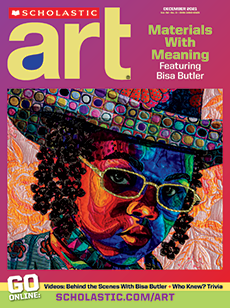KEHINDE WILEY: I was a young kid when I knew I wanted to be an artist. I was about 10 or 11 when my mother put my twin brother and me in art classes in Los Angeles.
Q&A With Kehinde Wiley
The artist offers Scholastic Art a glimpse of his life and his process
Portrait of Kehinde Wiley: © Mark Leong 2012 / Redux.
Wiley in his studio surrounded by some of his portraits.
SCHOLASTIC ART: When did you first know that you wanted to become an artist?
SA: Did you receive any awards or recognition when you were a kid?
KW: At the age of 12, I was sent on an exchange program called the Center for US/USSR Arts Initiatives. The experience opened my eyes to the broader world, different cultures, and different ways of seeing the world around me.
SA: What role did museums play in your early exposure to art?
KW: I grew up in South Central Los Angeles in the late ’80s, which was a dangerous time and place to be. Being able to escape to my art classes and to the museums in Southern California kept me busy and out of trouble.
SA: What challenges have you encountered during your career?
KW: I grew up in an environment that didn’t have the best access to quality art institutions, programs, and education. As a young person I was ambitious. I had to draw upon the few resources, the public resources, that were available to me.
Joao Caetano, 2009. Oil on canvas, 96 x 60 in. Courtesy of the Kehinde Wiley Studio and Roberts & Tilton, Culver City, California. Used by permission.
What characteristics in the portrait above tell you that the subject is a powerful leader?
SA: Why do you think portraiture is important in contemporary art?
KW: Portraiture has been the most important part of art-making in the history of mankind. We respond to a bowl of fruit very differently than we respond to a picture of ourselves. Why is that? Because we are interested in ourselves, where we’ve been, how we’ve gotten there. We as humans are storytellers and story makers, and portraiture is the beginning of every story.
SA: Why did you begin street casting?
This photo shows Kehinde Wiley, left, street casting in Brazil. The artist selected the man in the red shirt, below, and photographed him in the studio.
KW: When I came to New York, I was interested in doing a type of portraiture that engaged what I saw in the world around me, which was a type of black community that was radically different from South Central Los Angeles. There is a vibrancy in New York that I found really interesting. On 125th Street in Harlem, I would approach complete strangers and ask if I could paint their portrait. Some people would just keep walking; others became interested in what I was doing.
SA: How involved are your models in choosing their clothing and poses?
Joao Caetano. © Kehinde Wiley. Used by permission.
KW: The models are invited to wear their own street clothes when they pose for the paintings—whatever they are comfortable in. When the models arrive at my studio, we flip through my art history books together. They show me which paintings they are attracted to or relate to.
KW: The models are invited to wear their own street clothes when they pose for the paintings—whatever they are comfortable in. When the models arrive at my studio, we flip through my art history books together. They show me which paintings they are attracted to or relate to.
SA: Your portraits explore power. What about power interests you?
KW: By using subjects who come from underserved communities, I’m creating a global conversation around who has power and who deserves to be seen in the great museums throughout the world.
SA: What advice would you give to aspiring young artists?
KW: Be determined and curious. Take advantage of grants, scholarships, and art programs that are available. Draw upon the resources you have available to you.
